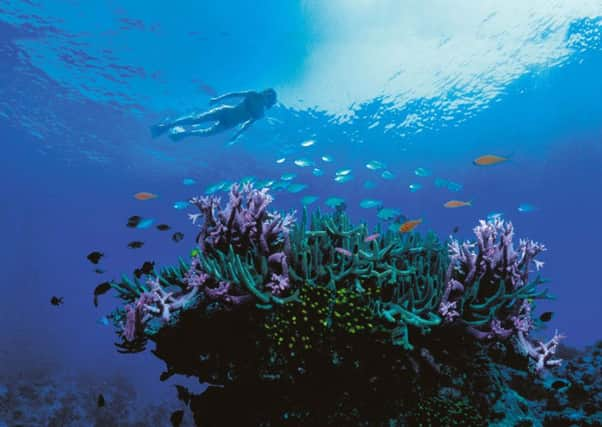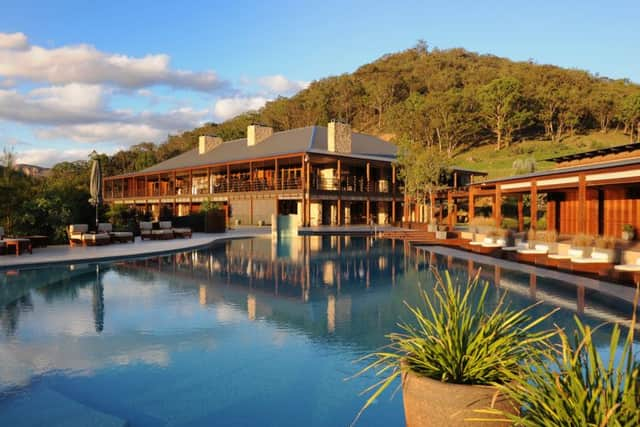Travel: Glimpse another world at the Great Barrier Reef


Electric blue, neon orange, iridescent turquoise and zebra-striped; I’m gliding through shoal upon shoal of fish in a mind-boggling array of shapes, sizes and colours, gazing at them as they go about their business, weaving in and out of a veritable fairytale forest of wavy, tentacled, or fringed clumps of coral. Some of the latter are pure, wedding dress white, while others run the scale from boring beige to rusty terracotta, with the occasional jolt of chalky blue and lavender in between. I float over a starfish, while the odd manta ray idly flaps past.
When we imagine alien worlds, we place them beyond the stratosphere, but one of the most incredible is to be found off the coast of Queensland, in north-eastern Australia. The Great Barrier Reef is one of the seven wonders of the natural world; the only living thing which can be seen from space, its 3,800 coral banks and islands stretch more than 1,600 miles. Composed of living coral – a reef is formed when thousands of tiny creatures establish a colony, or coral polyp, and build themselves hard exoskeletons to protect themselves from predators – the algae they harbour gives them their colour. When a polyp dies, a new one will form on the exoskeleton it leaves behind.
Advertisement
Hide AdHowever, despite it being dated back some 20 million years, this amazing phenomenon didn’t really start to come to the attention of the wider world until June 1770, when explorer Captain James Cook and his crew ran into part of it, crippling their ship, the Endeavour. Further explorations were made and by 1820, most of what we now recognise as the Barrier Reef had been officially charted. Today, we know that it’s home to over 1,500 different species of fish, and multiple varieties of whale, turtle, dolphin, shark and more.


You can access it from many different places along the coast, but one of the best is from one of the Whitsunday Islands, an archipelago less than three hours’ flight from Sydney. Not only will you be within striking distance of one of Australia’s most beautiful beaches, Whitehaven, but you’ll have the opportunity to see Heart Reef, an iconic, heart-shaped patch of coral which has graced innumerable Valentine’s cards and sparked many a marriage proposal. I base myself at Hayman Island, a small but lush tropical islet covered in palm trees and exotic plants, home to the luxurious One&Only resort. Its 160 rooms sprawl along the beachfront, with a spa for when all the relaxing gets a bit too much, and, of course, a well-equipped watersports centre.
Start, as I did, with a gentle snorkelling experience. Three locations are recommended; two bays which stretch a little further around the island’s coastline, or Langford Island, a short boat journey away. Once you’re equipped with flippers, a mask, breathing tube, and – between April and November, commonly known as “stinger season” a protective wetsuit – another world awaits.
You might spot a green turtle, paddling along placidly, or a tentacled cuttlefish. Consulting a chart after I got back on dry land, it turns out I spotted zebra fish, surgeon fish, clown fish and angel fish on my little journey. The more adventurous can go scuba diving, as the coral grows down to around 400m.
But almost more fascinating than seeing the reef from under the water, is seeing it from above it. The hotel offers seaplane or helicopter trips, which are a jaw-dropping way to take in its sheer scale. The clarity of the turquoise water means you can almost see down to the bottom; on my tour, the pilot points out a basking bull shark, a pod of dolphins, and more manta rays. Whale migratory season is between May and November, and unfortunately, I’ve come at the wrong time, otherwise I’d be able to spot one of these noble creatures as it comes up for air.


And if you fancy spending the day lying on some of the softest sand in the world, a boat will take you out to the five mile long Whitehaven beach. The sand is 98 per cent silica, meaning it’s pure white, and finer than sugar. Recently used as a location for the next Pirates of the Caribbean film, you’ll feel like you’ve been shipwrecked, but in one of the most beautiful places in the world.
Advertisement
Hide AdNo wonder two million people flock here every year. In recent years, however, there have been concerns about the future of the reef due to increases in tourist numbers – with their attendant issues of pollution – not to mention global warming. According to a study published in October 2012, the reef has lost more than 50 per cent of its coral cover since 1985. Hayman Island’s resident environmentalist, Douglas Van Wyk Smith, agrees there is cause for concern. “The warmer water means that the coral either dies off, or moves to deeper, colder water, while the cost to it from even the smallest amount of litter or rubbish is huge.
“That said, if we all do our bit and remain aware of these issues, there’s no reason we can’t carry on enjoying what is one of the most wonderful places on earth.”
Advertisement
Hide AdIt’s with some reluctance that I take my leave, but also excitement about seeing another great Australian natural wonder: the Blue Mountains. So-called because when the sun hits the eucalyptus trees which blanket them, a fine mist of oil is released, causing a blue haze to surround them, they stretch 60 miles north west from beyond Sydney. A series of imposing ridges, naturally carved from rust-coloured sandstone, large parts of them are divided into seven national parks and conservation areas. I’m heading to Wolgan Valley, a 7,000-acre sprawl of conserved land which is flanked by two of them, Wollemi and Gardens of Stone, which is home to the Emirates One&Only resort.
Opened in 2009 on the site of a former cattle ranch, it whispers mountain lodge chic – all stone walls, open fireplaces and leather armchairs and flaunts its impressive environmental and sustainability credentials (you’ll see solar panels everywhere). There are 39 double-bedroomed Heritage Suites, each with a private plunge pool, spacious living area and a deck from which to gaze at the sun-kissed or mist-shrouded peaks every morning. Oenophiles will be in heaven; winery regions such as Mudgee and Hunter Valley are not far away.
The resort rightly celebrates the Great Outdoors; its land is crisscrossed with hiking and mountain biking trails, although, in the spirit of the ranchers who originally made this their home in 1832, I saddle up and go for a ride.
You’ll see thousands of kangaroos, wallabies and wallaroos – all part of the same marsupial family, but with variants in their size, and the shape of their bodies – and if you’re lucky, you might even spot a wombat. Sadly, on this trip, I didn’t, but, like with my lack of whalespotting on the reef, there’s always next time.
• Spend four nights at One&Only Hayman Island (two people sharing a Lagoon Room including breakfast), followed by three nights fullboard at Emirates One&Only Wolgan Valley in a Heritage Suite, from £4,425 per person. Includes all economy flights, transfers and UK airport lounge passes. Valid 10 April-15 September (with some exclusions). For more, contact Elegant Resorts Reservations, 01244 897515 or visit www.elegantresorts.co.uk. For more on One&OnlyResorts, visit www.oneandonlyresorts.com